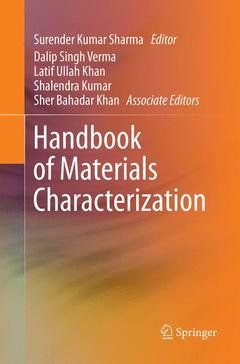Handbook of Materials Characterization, Softcover reprint of the original 1st ed. 2018
Coordonnateur : Sharma Surender Kumar

This book focuses on the widely used experimental techniques available for the structural, morphological, and spectroscopic characterization of materials. Recent developments in a wide range of experimental techniques and their application to the quantification of materials properties are an essential side of this book. Moreover, it provides concise but thorough coverage of the practical and theoretical aspects of the analytical techniques used to characterize a wide variety of functional nanomaterials. The book provides an overview of widely used characterization techniques for a broad audience: from beginners and graduate students, to advanced specialists in both academia and industry.
Chapter 1: X-Ray diffraction from polycrystalline materials: techniques and applications
1. Introduction
2. Basic properties and background of X-rays3. Principles of crystals symmetry
3.1. Crystal Types
3.1.1 Ideal Crystal
3.1.2 Real Crystal
4. Elements of X-ray diffraction
4.1. Interaction of electromagnetic waves and atoms
4.2. Concept of Reciprocal Space
4.3. Diffraction from Periodic Structures
4.4. Bragg´s law4.5. Laue´s Equation & Ewald sphere
4.6. Structure factor
4.7. Diffraction by crystalline aggregates
5.Instrumentation
5.1. Various components
5.2. Characterization by XRD5.3. Types of Scan
5.4 Sample loading and unloading
5.5 Software for XRD patterns analysis
6.Analysis of XRD data
7.Basics Concepts of Rietveld Method
8.Crystals Size and strain calculations9.Phases quantifying
10. Summary
11. References
Chapter 2: TEM for atomic scale studies: fundamentals, instrumentation and applications in nanotechnology
1. Introduction
1.1. TEM Overview1.2. TEM-What can we do?
1.3. Historical development of modern TEM
2. Basic Background and Principle
2.1. Light versus Electron Microscope
2.2. Resolution and its limitations
2.3. Electron Properties2.4. Advancement in Electron Microscopy
2.5. Imaging and micro-analysis
2.6. High Resolution Imaging
3. Instrumentation
3.1. Basic layout & components3.1.1. Electron Source
3.1.2. Electromagnetic lenses
3.1.3. Vacuum System
3.1.4. Electron Detectors
3.1.5. Other Components (Apertures)
3.1.6. TEM cross-sectional Model3.2. Functioning and operational Procedures
3.3. Sample Preparation
3.3.1. Basic criterion for successful TEM sample preparation
3.3.2. Preparation method
3.3.2.1. Nanoparticles
3.3.2.2. Bulk3.3.2.3. Layered structures
3.3.2.4. Thin Films
3.3.3. Artifacts Elimination
4. Imaging and Spectroscopy: a brief overview4.1. High resolution TEM imaging
4.2. Electron diffraction
4.2.1. Low Energy Electron Diffraction (LEED)4.2.2. Reflection High Energy Electron Diffraction (RHEED)
4.3. Chemical Mapping
4.4. Electron energy loss spectroscopy5. Data Processing and software
6. Future prospects
5. Acknowledgment
6. ReferencesChapter 3: Importance of scanning electron microscopy in the morphological characterization of nanomaterials
1. Introduction
1.1. Scanning Electron Microscopy
1.2. Importance of Scanning Electron Microscopy
1.3. Basic Principle
1.4. Advancement in Scanning Electron Microscopy
1.5. Imaging and micro-analysis
1.6. Electron Diffraction Analysis
2. Instrumentation
2.1. Basic layout
2.2. Functioning and operation
2.3. Sample Preparation & staining
2.4. Artifacts Elimination
3. Application of scanning electron microscopy in materials science
3.1. Nanomaterials
3.1.1. Nanowires
3.1.2. Quantum Dots 4. Summary
5. Acknowledgment
6. References
Chapter 4: Scanning force microscopy: basic concept, instrumentation and applications
1. Introduction to Scanning Force Microscopy
1.1. Atomic Force Microscopy
1.1.1. History and background of AFM
1.1.2. Basic component of an AFM
1.1.2.1. General components and their functions
1.1.3. Tip-Sample interactions and feedback mechanism
1.1.4. Atomic force and different scanning modes
1.1.5. AFM tip and resolution1.2. Two special modes of AFM
1.2.1. Magnetic Force Microscopy
1.2.1.1. Dual Scanning
1.2.1.2. Advantages of MFM imaging
1.2.2. Electrostatic Force Microscopy
2. Experimental Details
2.1. Thin film deposition of Co on Si
2.2. Characterization performed
3. Results and Discussion
3.1. Data analysis
3.2. Application in nano and hybrids composites
4. Summary
5. References
Chapter 5: Characterization of nanomaterials using dynamic light scattering: basic concept and applications
1. Introduction
2. Basic concept of light scattering
2.1. Interaction of light with Matter
2.2. Total intensity light scattering3. Dynamic Light Scattering
3.1. Characterization using dynamic light scattering
3.3.1. Particle size3.3.2. Particle Electrostatics
3.3.3. Zeta potential
3.2. Theory4. Experimental
4.1. Instrumentation
4.2. Data analysis methods for DLS measurements5. Future prospects
6. Acknowledgment
7. References
Prof. Dr. Surender Kumar Sharma has obtained his PhD in July 2007 from Himachal Pradesh University, Shimla India. After spending several years in research/academic positions in Brazil, France, Czech Republic, India and Mexico working in the area of nanomagnetism and functional nanomaterials, he has joined Federal University of Maranhão, Brazil, as a Professor of the Department of Physics, where he stands since February 2015. Currently he is an active member of the Graduate research program at UFMA and actively involved in research, teaching and supervising research students at UG/G levels. He has been awarded as FAPEMA Senior Researcher award in August 2015. To date, Dr. Sharma has published more than 70 research articles in reputed journals, 3 books as a single author and 3 book chapters.
Dr. Dalip Singh Verma obtained his PhD in Physics in 2008 from Panjab University, India. During his PhD, he spent a few months at Frankfurt Institute of Advance Studies, Germany, as part of his PhD thesis. Later, he served as an Assistant Professor in Physics at Government College for Girls, Sector-11 Chandigarh and Government College Bassa, District Mandi (H.P.) India. Since 2012, he is working as an Assistant Professor in Physics at Department of Physics & Astronomical Sciences, Central University of Himachal Pradesh, Dharamshala, Kangra (H.P.)-India.
Dr. Latif Ullah Khan has obtained his PhD in Inorganic Chemistry (2015) from Institute of Chemistry, University of São Paulo, Brazil. Currently, he is working as a researcher (postdoc) at Brazilian Nanotechnology National Laboratory (LNNano), CNPEM, Campinas-SP, Brazil. His research interests include design and characterization of optical and magnetic nanomaterials as well as their toxicity assessment in zebrafish and c. elegans models using m-XRF images, in correlation with Cytoviva hyperspectral images and confocal laser microscope images. In addition, application of these nanomaterials for t
Provides comprehensive information on the structural, morphological and spectroscopic characterization of materials
Addresses theoretical and experimental aspects alike, with special emphasis on sample preparation and experimental setup
Includes sections devoted to instrumentation and data interpretation for each technique covered
Date de parution : 12-2018
Ouvrage de 613 p.
15.5x23.5 cm
Date de parution : 10-2018
Ouvrage de 613 p.
15.5x23.5 cm



